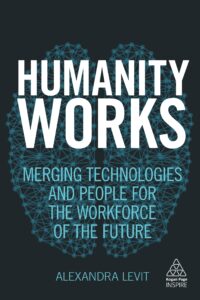Humanity Works
The professional landscape is transforming, and the only way to maintain competitive advantage is to maximize the unique skills of your workforce. In Humanity Works: Merging Technologies and People for the Workforce of the Future, consultant and futurist Alexandra Levit provides a guide to making the most of the human traits of creativity, judgment, problem solving and interpersonal sensitivity.
If you’ve ever wondered what the ‘robot takeover’ will look like, how talent and machines can work side by side and how you can make organizational structures more agile and innovation focused, you will be interested in Alexandra’s work. I recently spoke with her about her research and observations.
When Robots Do More
You cover some sweeping trends. Would you share a few of the macro themes that are the backdrop of your work?
The book addresses a few essential questions: In a world where robots can do more and more, where does that leave us as humans? How will leaders build integrated human teams that can compete in a business world with constant evolutions and disruptions while remaining productive, marketable and sane? We explore the demographics, technological advances, work structures, organizational priorities, leadership models, individual career paths and human roles coming to fruition in the immediate years to come.
As you look at the workplace of the future, what are a few of the major changes we will see?
By 2035, most organizations will not have large, company-sponsored physical offices but instead will lease chains of interconnected hubs for both full-time and contract employees to work and meet when they need to. This kind of flexibility will, however, have its downside.
Thanks to the rise of the Rateocracy pioneered by websites like Yelp!, customers will evaluate your products and services in real-time and will expect concerns to be addressed immediately.
We must also contend with unprecedented diversity. As of this year, there will be five generations in the workforce, led by many traditionalists (born before 1945) and baby boomers (born 1945-63) who are determined to contribute to their organizations beyond typical retirement age. Due to the small size of Generation X (born 1964-79), the millennials (born 1980-95) are moving into leadership positions an average of 10 years earlier than their predecessors and require extensive learning and mentorship to be effective managers.
The oldest members of Generation Z (born 1996-2012) are now graduating from college and arriving in the workforce expecting to wield technology for instant business impact. Organizations that want to keep top Gen Z talent must provide tools that allow them to do their jobs with maximum efficiency.
Members of all generations who wish to be gainfully employed will come face-to-face with a different set of hiring practices. For instance, your competition for jobs won’t simply be in your backyard but will be all over the world thanks to virtual and remote work and larger populations of working-aged people in China and India, which will shortly become the leading exporters of qualified talent.
In the work world of 2035, team work will be shorter-term in nature and involve high levels of human and machine collaboration. Constant innovation will be a given, meaning that if you want to keep pace with technology and use it to drive business results, you can’t wait for a vendor or consultant to hand you a solution. You must take development into your own hands.
What should leaders do to adapt their organizations in the midst of these changes?
The answer is simpler than you might think. Focus on your best people, in all generations from all backgrounds, and with various work arrangements – and empower them with the right tools. Also, go out of your way to develop the uniquely human skills of creativity, judgment, intuition, and interpersonal sensitivity in your employees so they are automation-proof and better equipped to work effectively alongside machines.
The Culture of 2030
Talk about the organizational culture needed in 2030 to be competitive.
The type of culture that will resonate in the future world of work is, first and foremost, purpose-driven – meaning that it arises from understanding what your company is deeply passionate about, what it is best in the world at and what drives it economically. As organizations get flatter and leadership and employment become more transparent, effective cultures will increasingly emphasize accountability, efficiency and concrete contributions.
How about the CEO of the future?
 Future CEOs will connect individual goals to the organization’s larger purpose, incentivizing and inspiring employees to buy in and commit to the vision versus communicating that they have no other choice. This is sometimes referred to as transformational leadership, and enlightened 21st-century leaders will abandon command-and-control to diplomatically govern their organizations.
Future CEOs will connect individual goals to the organization’s larger purpose, incentivizing and inspiring employees to buy in and commit to the vision versus communicating that they have no other choice. This is sometimes referred to as transformational leadership, and enlightened 21st-century leaders will abandon command-and-control to diplomatically govern their organizations.
What skills will be most important to develop in the next few years to prepare?
Uniquely human skills that are difficult to automate and are essential to collaborative work with smart machines include empathy, creativity, intuition, judgment, and interpersonal sensitivity. As an example, today’s business world is all about speed and agility, and as such, the ability to make rapid and accurate judgments will become increasingly valuable competitive differentiators for human professionals.
For more information, see Humanity Works: Merging Technologies and People for the Workforce of the Future.

